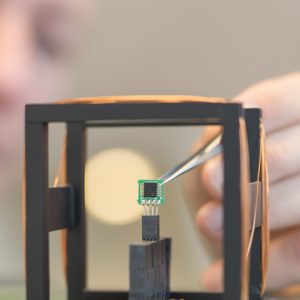ABOUT THE PROJECT
State-of-the-art electric propulsion (EP) systems used in satellites may exhibit impressive performance, but the used technologies cannot be scaled down in size and power whilst retaining system performance. As a result, no conventional technologies for propulsion are available for the upcoming micro- and nanosatellite market. SystematIC partners in the HiperLoc-EP project which aims to use a novel electric propulsion approach and develop an Electrospray Colloid Electric Propulsion System (ECEPS) suitable for small (cubesat) form factors.
The HiperLoc project seeks to develop a disruptive electric propulsion technology that provides a high performance EP system – to a cost that is at least one order of magnitude lower than today.
CHALLENGE
The propulsion system requires ions to be extracted and accelerated using high voltages in the order of several kiloVolts. In order to maintain charge neutrality a balanced system is used, which means both negative and positive high-voltage pulses are needed which can be controlled in amplitude and width. For small satellites the power level that is needed is much smaller than what the few available of-the-shelf high-voltage switches are optimal for. The challenge for our electronics development is to achieve good control, good efficiency at low-cost and suitable for small form-factor implementation.
SOLUTION
SystematIC develops a dedicated and miniaturized power control system for the Electric Propulsion unit. We succeeded in obtaining the relevant system performance like high efficiency and accurate high-voltage control, taking into account space industry requirements for latch up protection and redundancy.
Our understanding of power-conversion techniques as well as our knowledge of circuit integration helped a great deal to realize this. For this application we developed of a dedicated high-voltage (but low-power) switch ASIC in an XFAB HV technology. A complete system demonstration unit is targeted for end of 2018.
The following functions are implemented in our PPU (Power Processing Unit):
- Efficient high voltage generation
- Accurate high-voltage switching and control
- Microcontroller-based control, detection, protection and communication

TIME
Several years of R&D in multiple generations of high-voltage power units for Electric Propulsion, starting in the FP7 project called MicroThrust and taken to the next readiness level in the H2020 project called HiperLoc.
WE ARE PROUD
SystematIC is succesfully cooperating in multi-disciplinary international consortia for space-industry developments.
SystematIC demonstrated high-performance electronic power units for EP using low-cost components and a novel high-voltage (7.5kV) switch topology based on a specific ASIC which SystematIC developed in a 650V CMOS technology.
KEY TECHNICAL STATISTICS
- High voltage generation from 12V input to +/- 3kV outputs with 10W output power
- High power conversion efficiency 83%
- Accurate voltage control to maintain satellite charge neutrality
- Solid-state high-voltage switch matrix design with >7.5 kV breakdown
- Microcontroller driven control algorithms and communication
WATCH A VIDEO ABOUT THE HIPERLOC PROJECT
SystematIC converted this idea into a high-level system model which allowed simulation of the audible effects of the algorithm on recoded sound fragments and this helped to improve the algorithm.
OUR OTHER SUCCESS STORIES
Successful achievement of your company’s goals will require IC solutions that are tailor made for your business needs. SystematIC was founded to help businesses imagine, plan, and develop these IC solutions.











